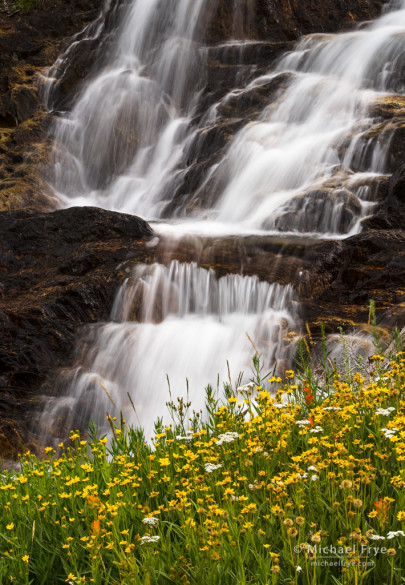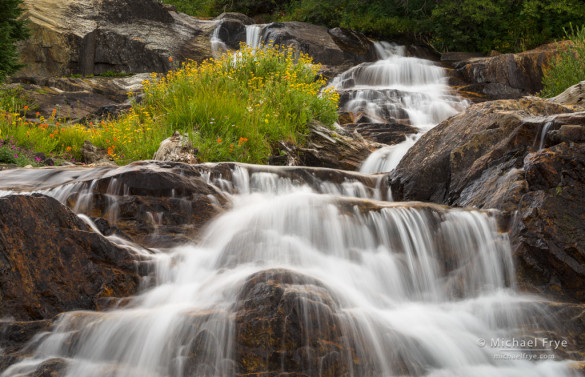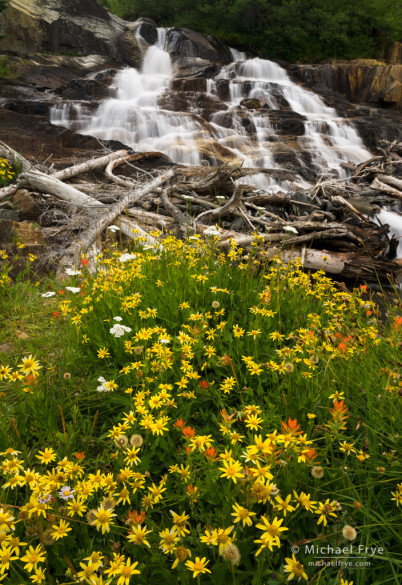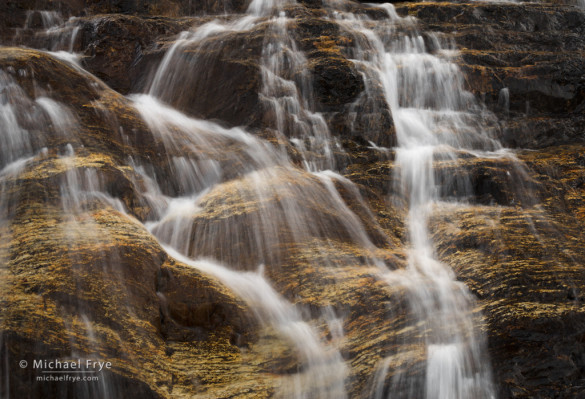It’s been an interesting summer in the Sierra. Last winter was one of the driest on record, but over the last month or so we’ve seen a steady flow of monsoonal moisture flowing up from the southeast, leading to frequent afternoon showers and thunderstorms over the higher elevations. We even heard about an epic deluge two or three weeks ago that flooded the parking lot and some of the tent cabins at the Tuolumne Meadows Lodge.
That extra moisture has kept the streams flowing and flowers blooming in the high country longer than I would have expected. On Saturday Claudia and I hiked up one of the eastern Sierra canyons and found a pretty series of cascades, with an island of late-summer flowers in the middle.
Although I make my share of black-and-white photographs, I’ve always been attracted to color. I often look for color, then try to build a composition around it. As I tell my workshop students, color isn’t enough – you need to find a design to go with that color.
In this case, that design proved to be elusive. The most obvious composition was a wide-angle view with a patch of flowers at the bottom, and the upper cascade above. But there was a distracting pile of logs at the base of the cascade that cluttered the image, with no obvious way to eliminate or minimize the logs. I have nothing against logs, but in this case I was interested in the flowers and water, and the logs broke up the visual flow between the flowers and water, diluting the photograph’s message:
So I kept looking. When trying to juxtapose two different elements proves difficult, you can sometimes solve the problem by just focusing on one of those elements. I thought the cascade itself was interesting, especially since it flowed over some beautiful gold-colored rock (there I go again, looking for color). I made several compositions of one section of the upper cascade, including the one below. This has patterns created by the zigzagging strands of water and the ledges, plus some color, and light-and-dark contrast:
But while I liked that image, I have many similar photographs of cascades and waterfalls. It was that rare juxtaposition of flowers and water that really interested me, and I was determined to find a clean, strong composition with those two elements – or at least to explore every possible angle until I was satisfied that no such composition existed.
I looked at some nearby possibilities, but none seemed to work. Then I hopped across the creek and worked my way down below the next tier of the waterfall. There I noticed that it might be possible to position the island of flowers between the upper and lower tiers of the cascade, filling the frame with just the two essentials – water and flowers – while hiding the distracting log pile. Working along both sides of the creek below the second tier, I tried at least half a dozen different variations on this idea, of which the photograph at the top of this post is, I think, the most successful. The zigzags and diagonal lines of the water create a pattern, while the patch of flowers provides a focal point.
Next, I moved to the base of the second tier, where I saw a possible juxtaposition of that lower cascade with a patch of flowers at its base. Again, some distracting logs limited the possibilities, but stepping back with a longer lens narrowed the angle of view, and allowed me to keep the logs out of the frame. Here the lines created by the top edge of the flowers and the V-shape of the water form patterns of diagonals and triangles, and the whole frame is filled with only the two essential elements: water and flowers:

Wildflowers and waterfall, eastern Sierra. 70mm, 100 ISO; since the depth of field was too great to get everything in focus in one image, I took four frames at 1/2 sec. and f/16, each focused at a different distance, and blended them together with Helicon Focus.
Sometimes a scene just composes itself. You walk up, immediately see the composition, know where to stand, and even know approximately what focal length to use.
But other situations are more challenging. Something catches your eye, but the composition is not immediately obvious, perhaps because there’s some distracting element in front of, next to, or behind the subject (like those logs). You may look and look and never find a composition that works, but sometimes, if you look deeply enough, there is a solution.
First, ask yourself what caught your eye in the first place. The more specific your answer, the better. In other words, don’t just say, “I like that tree.” What about the tree? Is it the shape? The color? The texture? The light? Is it a relationship between the tree and something else?
Then, once you’ve narrowed your focus, and identified the essential elements, try every possible angle, and look for ways to showcase those essentials while keeping the composition simple, and eliminating distractions.
In this example, the essential elements were, to me, obvious: the flowers and water. What wasn’t so obvious was how to simplify the scene and distill the composition down to those essentials. But I just kept looking, which is all you can do. Even if you never find a solution, the process will teach you a lot about composition, and increase your chances of finding a solution the next time.
— Michael Frye
Related Posts: What’s the Least Interesting Part of This Photograph?; When Separation is a Good Thing
Did you like this article? Click here to subscribe to this blog and get every new post delivered right to your inbox!
Michael Frye is a professional photographer specializing in landscapes and nature. He is the author or principal photographer of The Photographer’s Guide to Yosemite, Yosemite Meditations, Yosemite Meditations for Women, and Digital Landscape Photography: In the Footsteps of Ansel Adams and the Great Masters. He has also written three eBooks: Light & Land: Landscapes in the Digital Darkroom, Exposure for Outdoor Photography, and Landscapes in Lightroom 5: The Essential Step-by-Step Guide. Michael written numerous magazine articles on the art and technique of photography, and his images have been published in over thirty countries around the world. Michael has lived either in or near Yosemite National Park since 1983, currently residing just outside the park in Mariposa, California.












Love the focus of the flowers and flowing of the water with the leading angles. Would love more info on Helicon Focus.
Thanks Mary! Helicon Focus is one of many focus-stacking applications out there. I haven’t tried all the others, but Helicon Focus works well. It resizes and aligns the different images, and picks the sharpest parts of each one to include in the final blended image.
Great images and very useful information on thought process. This is what I struggle most with (and with simplifying compositions). Do you choose to use polarizer with the type of water shots?
Thanks Bart – hope that was helpful. Yes, I used a polarizing filter on all these images to cut reflections on the wet rocks. This enhances colors and contrast. If the water had reflections – like gold reflections from sunlight hitting mountains and reflecting into the water – I wouldn’t use the polarizer.
Your story, just like your photos, really does get down to the essentials. Thanks for the great advice.
Thank you Kevin, and you’re welcome!
Thanks for posting your thinking regarding difficult compositions. Difficult compositions come up so many times when I’m shooting. If I THINK about what I’m trying to do – i.e., clarifying the essentials – I can eliminate so many of the hit-or-miss shots I take as I struggle to find a good composition.
You’re welcome Vivian, and thanks! I hope you’re able to cope with some of those difficult compositions better in the future.
Excellent post as always. They inspire.
Thanks Malcolm!
Michael,
I am always revitalized when I view your photography and writing style, especially from your treks in my favorite Sierra Nevada. As a very inexperienced amateur, I am captivated at how you get water flows to look like sparkling, spun silk.
Thanks Ann! There’s no big mystery about how to get water to look like that – you just need to use a slow shutter speed on a tripod. Typically the speed ranges from 2 seconds up to 1/8th of a second, depending on the relative motion of the water across the frame, and the look you’re after.
Considering what’s said and will look forward to reading others thoughts!
Michael — An excellent article and valuable lesson for all of us. I’d hope that you would collect up all teaching pieces you have on your blog and put them into an eBook. There is value in juxtaposing these lessons. Thanks for all you do for the community! Best, Frank
Thanks very much Frank. I may just take you up on that ebook suggestion. 🙂
(this post as well) Great tips Michael, I find myself arriving to a pre-scouted location looking for options constantly parosing the scene and even in the middle of the shoot finding that magic “point of view”. Ansel Adams really did emphasis the “what if” moment with his previsualizing exercises. I try to exhaust all the options and only realize their limits after the fact in post. I suppose that is why the scene keeps bringing be back for another look. My “cornfield collection” on my website is that best effort. Thanks Michael – great advise.
Thanks Joseph – glad we’re thinking along the same lines.
I found your Getting Down to the Essentials most valuable for the lessons it taught in being persistent in trying different solutions to the composition of the photo. The article showed you worked at this, and I thank you for your effort. Explaining what didn’t work (or was part of your portfolio anyways) was just as valuable as showing us what finally did work.
You stuck to your guns and left the scene untouched, but photographed.
Thanks Wei Chong – I’m glad you found this helpful!